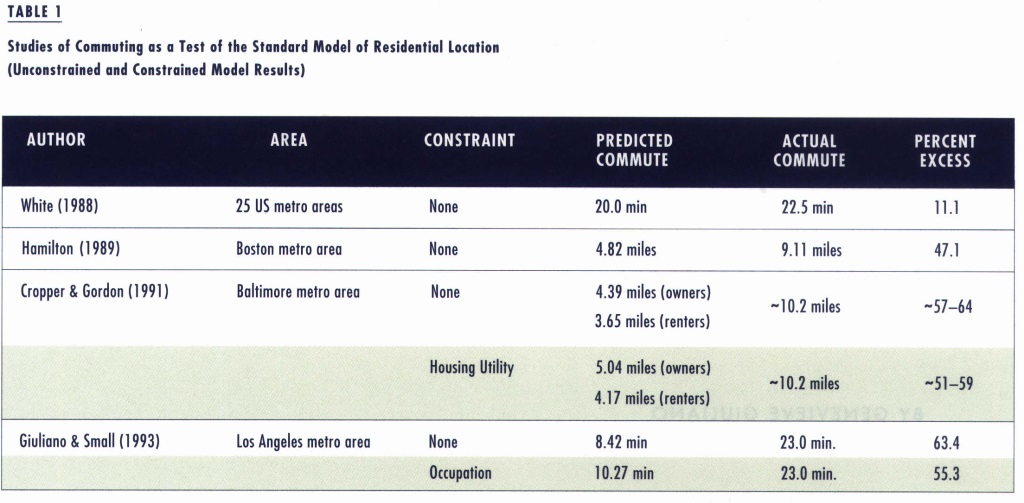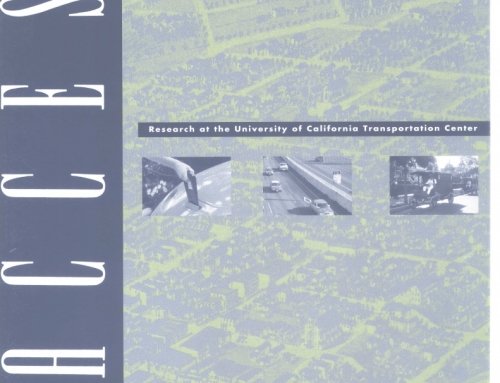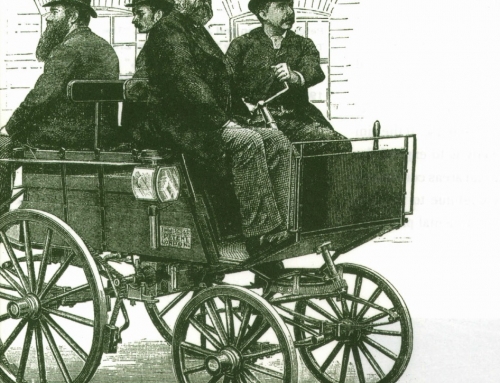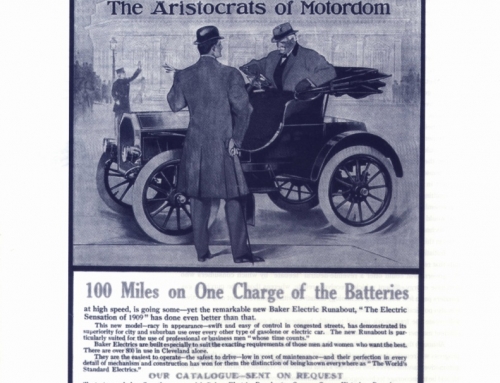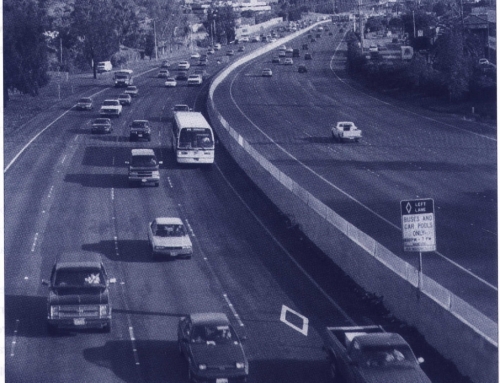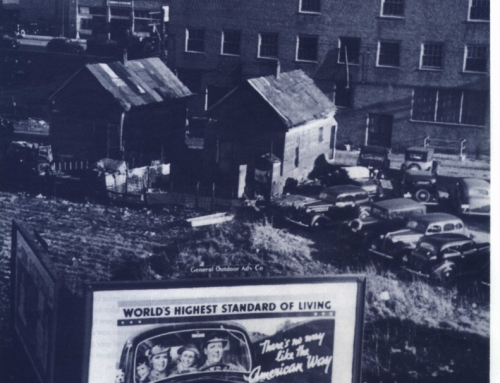[sharelines]Direct policies are needed to tackle problems stemming from transportation-land use connections.
The precise relationship between transportation and land use continues to elude us. It seems self-evident that transportation facilities and services have enormous effects on land use patterns. We’ve all observed developments occur around freeway interchanges, and we all know the history of automobile-oriented suburban development. However, when we look beyond broad generalizations, we see far more complex and uncertain relationships, as well as a cluster of unsubstantiated beliefs.
A large body of formal theory contends that the basic factor underlying these relationship is accessibility – the ease of connection between places. As contact between two places becomes cheaper in time and money, accessibility increase. The propensity for people to interact with others at a distance increases as the cost of access decreases. Urban theory tells us that people locate their houses and their workplaces by trading off housing and commute costs. Commuters choose residential locations that satisfy both housing needs and workplace access, and employers choose work sites that are accessible to employees at tolerable time and dollar costs.
The simplest version of the standard urban economic theory assumes that:
- All employment is fixed and located at the city center;
- All households have only one worker, and each considers only work travel;
- Housing depends on available capital and land, and therefore location and lot size are the distinguishing factors; and
- Unit transportation cost includes both time and monetary costs, and it is constant and uniform in all directions,
This residential-location theory predicts a city form with greatest population density and highest land value at the center (even though we know that many subcenters may surround the metropolitan center). Since the theory assumes that jobs are located at the major center, it predicts that average commute trip length will correspond to the mean distance of the total population from that center.
Several recent studies have tested these propositions empirically, Table 1 gives some results, Note that, with one exception, observed average commute distance, whether measured in minutes or miles, far exceeds the model’s prediction. Why do people have much longer commutes than the standard theory predicts?
Is It Jobs-Housing Balance?
First, there may be imbalances or mismatches between workers and jobs.
Imbalances occur when the number of workers who can be housed in an area differs from the number of jobs there. Mismatches occur when prices or other characteristics make housing in the area unsuitable for workers who hold jobs there.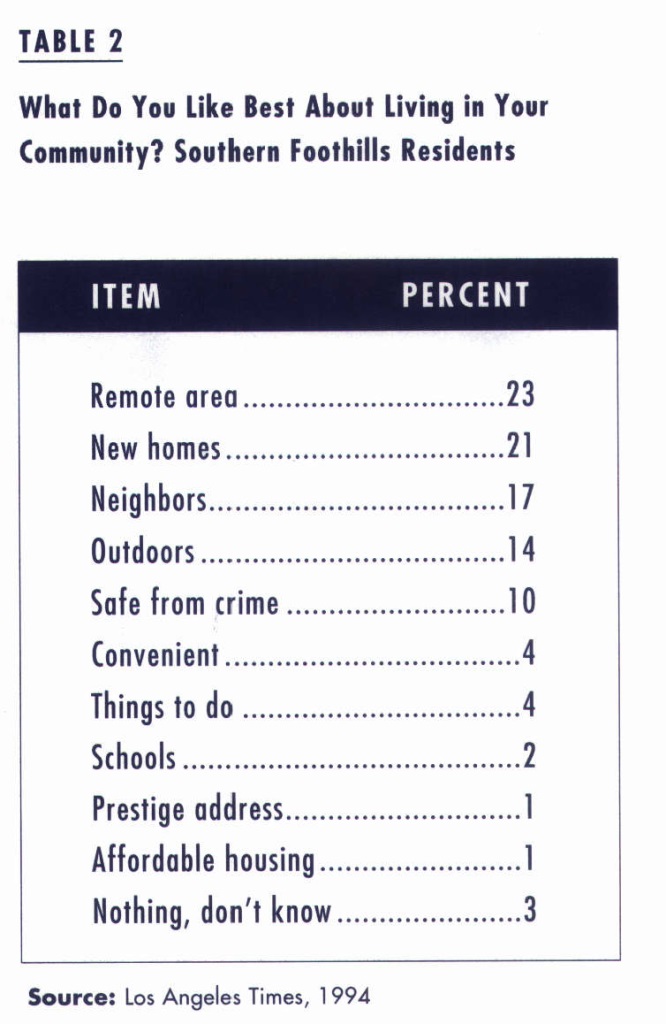
Kenneth Small and I examined the effect of the jobs-housing balance on average commute distance. We found that only extreme imbalance has a noticeable effect on average commute length because the difference between the observed commute and the predicted commute diminishes as the average distance between workers and jobs increases. In other words, there is more “excess” commuting close to the city center, where jobs and housing are balanced, than farther away, where they are not.
What about mismatches? Researchers have cited exclusionary zoning practices, growth controls, rising development costs, and rapid economic growth to explain a shrinking supply of affordable housing in many metropolitan areas. If affordable housing were available near their jobs, the theory goes, these workers would have shorter commutes. We can test this idea by incorporating housing and household characteristics into our model’s predictions.
Two studies applied such constraints: Cropper and Gordon’s Baltimore study used housing characteristics as the constraint, and our Los Angeles study used worker occupation as the constraint. The shaded portions of Table 1 show the strikingly similar results. The predicted average commute increases by about 20 percent in both cases, but it leaves a large portion of actual commuting still unexplained. I conclude that imbalances or mismatches between jobs and workers do not account for a substantial part of observed commuting patterns.
Is It Low Transportation Costs?
Second, observed average commutes maybe longer than predicted because transportation costs are low relative to housing costs. Over time, the real cost of commuting has dropped dramatically. Turn-of-the-century streetcar commuters spent about 20 percent of their daily wages on the work trip; urban auto commuters today spend about 7 percent. It therefore seems reasonable that workers would incur longer commutes in order to obtain more preferred housing and neighborhood surroundings.
Changing Lifestyles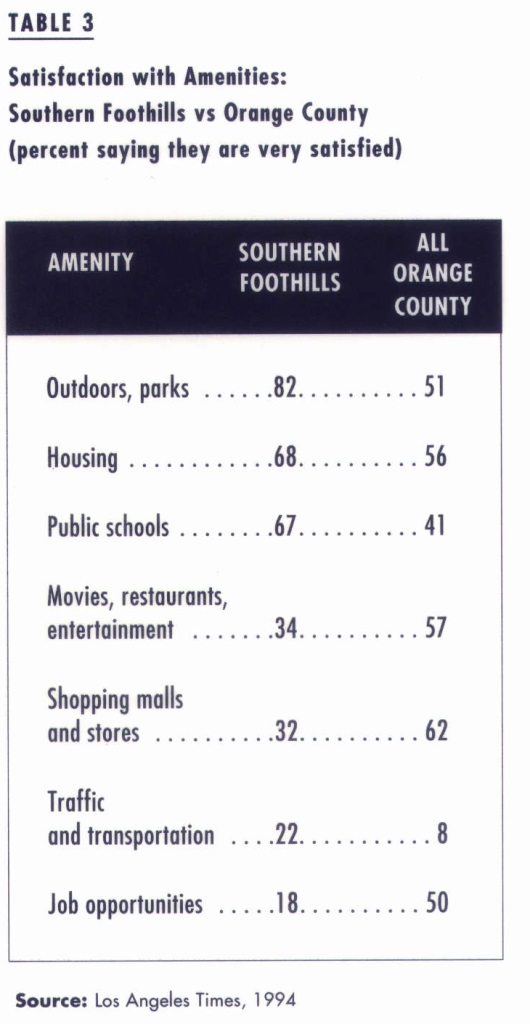
A survey conducted in Orange County, California, illustrates the changing factors affecting where people choose to live. In February 1994, the metropolitan newspaper sponsored a random telephone survey of 600 residents to examine attitudes about living in several planned communities at the southeast edge of the county. Known as the Southern Foothills, the area is surrounded on the east by a national forest and on the south by a large military installation. Only two major roads connect this “urban fringe” with the rest of the county.
One of the questions asked was, “what do you like best about your community?” Table 2 shows that the most frequent choice was “remote area.” The residents enjoy living far from the metropolitan core. Convenience, the only measure of accessibility on the list, ranks sixth. Affordable housing is at the bottom of the list, although the survey included respondents from moderately priced housing in the area, as well as from a variety of housing developments.
The survey also provides evidence of what these residents are willing to give up in order to live in a remote, semi-rural environment. Table 3 shows that Southern Foothills community residents display greater satisfaction with outdoor amenities, housing, and public schools than do Orange County residents as a whole. They display less satisfaction with entertainment, shopping, and job opportunities, suggesting they are willing to give up access to jobs and other urban activities to obtain preferred housing and neighborhood amenities. Limited accessibility is also reflected in average commute length: 36 minutes for Southern Foothills residents compared to the countywide average of 25 minutes.
This evidence indicates that commuting considerations play a limited role in residential- location choices for these folks. It suggests that attempts to alter the structure of urban land use patterns via policy intervention may not have much effect on commuting patterns, even if they are successful in changing the degree of jobs-housing balance or in reducing mismatches.
Transportation Investments’ Effect on Land Use
If transport costs do play an important role in location choice, then transportation improvements should influence land use patterns. Any significant improvement in accessibility should be capitalized in land values, which should spur shifts in land use. That’s why planners advocate investment in transportation facilities as a means to direct urban development.
However, today’s metropolitan areas are marked by well-developed transportation systems. Even a large investment (such as a new freeway segment) will have only an incremental effect on accessibility. For example, the $2 billion, 17-mile Century Freeway (I-105) in Los Angeles, 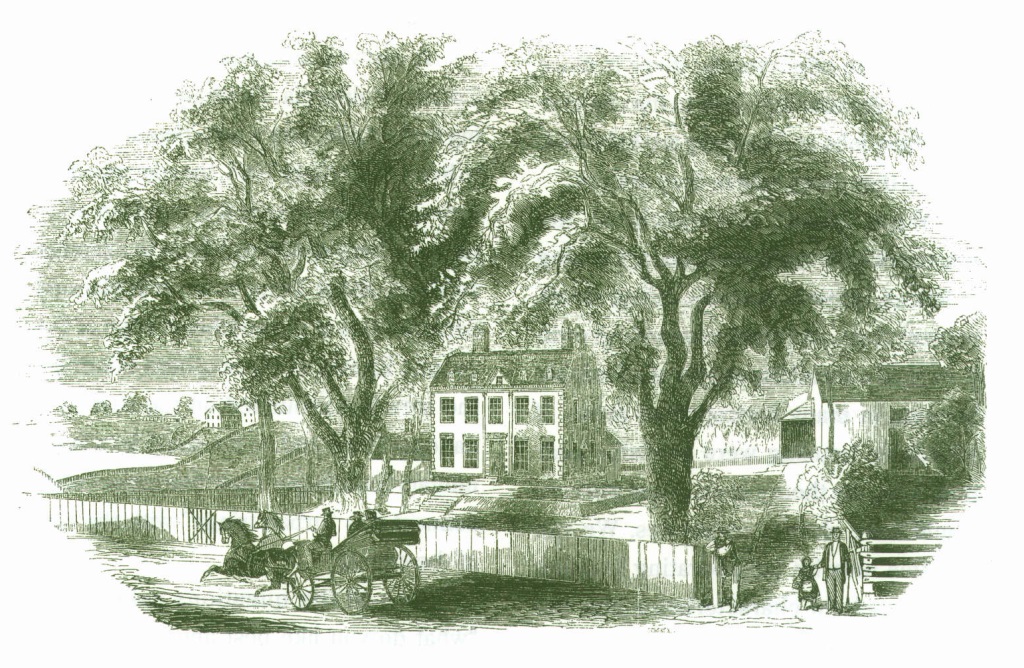 which opened in 1993, serves only 0.6 percent of the region’s total daily vehicle trips, based on 1994 average daily traffic volumes. Moreover, the decentralized land use pattern of today’s metropolitan areas has reduced differences in accessibility among locations.
which opened in 1993, serves only 0.6 percent of the region’s total daily vehicle trips, based on 1994 average daily traffic volumes. Moreover, the decentralized land use pattern of today’s metropolitan areas has reduced differences in accessibility among locations.
Despite what I consider rather overwhelming evidence that transit investment is not an efficient means for affecting land use patterns, rail transit continues to have strong public support. The most extreme example of a public commitment is perhaps Los Angeles County’s. Traffic congestion and air pollution problems there have prompted a transportation vision involving a $78.3 billion rail-transit investment plan (currently being scaled back because of funding problems). Planners expect this massive program to increase the proportion of commuters who use transit from 4.5 percent to 19 percent by the year 2010. They also expect to generate high-density and mixed-use development along transit lines and to reduce the spread of suburban development in outlying areas.
To test whether their expectations were reasonable, the regional planning agency sponsored a study using a transportation forecasting model to determine the effect of various land use scenarios on transit use. Results show that by relocating 75 percent of all forecast employment growth and 65 percent of population growth in the region (Los Angeles and four other counties) to transit-station capture areas and local activity centers, 7 to 10 percent of commuters would use transit-much below the goal of 19 percent. Study authors conclude that even if anticipated land use changes were to occur, travel patterns would not change very much, because the overall regional pattern of land use would not change very much.
The Oregon Example
A study in Washington County, Oregon – a suburban area west of central Portland – also finds that both land use policies and major transit investments have little effect on regional travel patterns. Regional forecasts to 2010 predict a 60 percent population increase (from its 1988 level 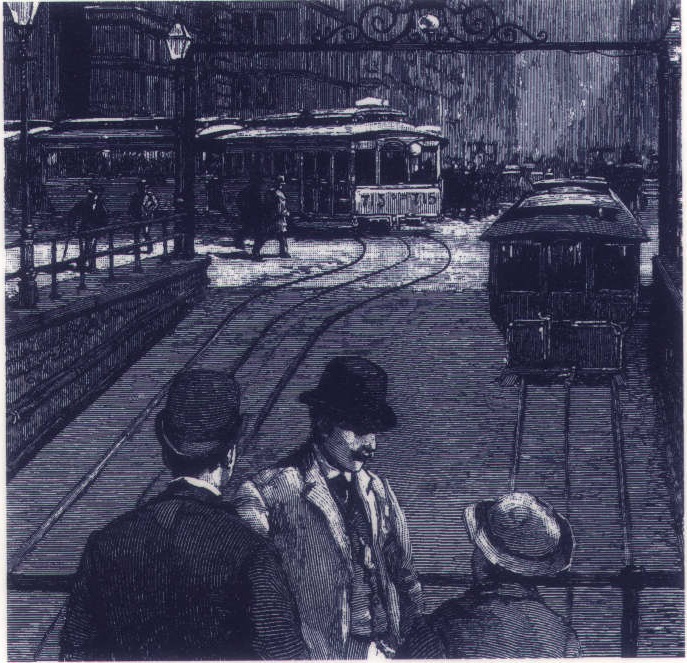 of 287,000) and a 70 percent increase in the number of jobs. To accommodate this anticipated growth, the Oregon Department of Transportation planned a freeway extension called the Western Bypass.
of 287,000) and a 70 percent increase in the number of jobs. To accommodate this anticipated growth, the Oregon Department of Transportation planned a freeway extension called the Western Bypass.
Community activists persuaded the transpo1tation department to sponsor a study called LUTRAQ (Land Use Transportation Air Quality Connection), which proposes development of higher density, mixed-use communities oriented to pedestrian and transit travel. To serve the more clustered land use pattern, the LUTRAQ alternative employs an expanded light-rail system, expanded local and express bus services, transit shuttle service, and bicycle and pedestrian facilities. It also eliminates the Bypass highway improvements.
A second alternative, LUTRAQ-II, promotes further transit use by incorporating an additional transportation-demand-management (TDM) element. All workers in the study area would enjoy free transit; but if they drove to work they would pay a parking charge equivalent to one-third of prevailing fees in downtown Portland.
Table 4 shows that the Bypass and LUTRAQ-I alternatives would have similar transit mode shares. With the LUTRAQ-II alternative, the transit and carpool mode shares for home-based work trips would each be 45 percent higher than with the Bypass alternative. Changes in the transit mode share are minor in other categories.
Another objective of LUTRAQ is to reduce vehicular travel. The last column in Table 5 compares the LUTRAQ-II and Bypass alternatives. With LUTRAQ-II, vehicle use would be reduced 7.7 percent for afternoon peak vehicle hours of travel and 13.6 percent for vehicle miles traveled. Note also the increase in vehicle hours of delay for the LUTRAQ alternative, an expected result of reducing investments in road facilities.
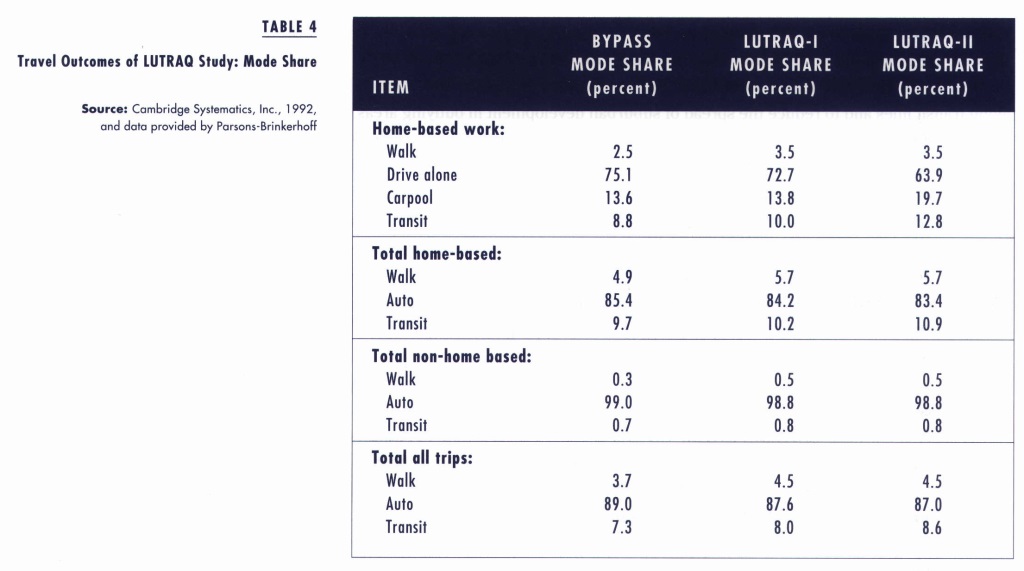
What can we conclude from these results? Land use policies appear to have little impact on travel outcomes; most of the observed change is due to the TDM policies, rather than to the land use and transit policies. Without TDM, travel impacts of the LUTRAQ alternative are minor.
Although changes in travel outcomes are small, the magnitude of change in land-use patterns for the LUTRAQ alternative is large. It seems development density must increase dramatically if we want to induce significant change in mode shares and trip lengths. That implies more stringent land use controls than have historically been possible in the United States.
Can Transportation Policy Shape Urban Form?
Regional scientists and others predict continued decentralization and reliance on personal modes of transportation. Increasing affluence of the population and structural economic shifts to information-based activities will engender decentralization. Rising incomes will generate demand for more housing (at lower densities) and will increase the value of one’s time (with more demand for private vehicles). We expect structural shifts in the economy to be accompanied by more flexible work arrangements and less clustering among firms, implying more spatial dispersion. We expect more leisure activities and an increased emphasis on environmental quality in choosing household’s and firm’s locations, again suggesting more decentralization.
Thus, scholars view transportation as an ineffective means for shaping urban form for three reasons: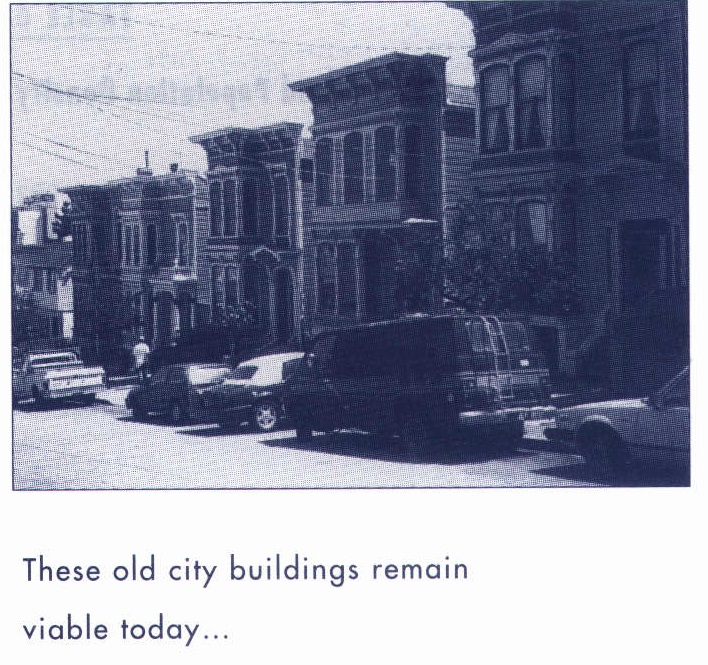
- The transportation system in most U.S. metropolitan areas is highly developed, and therefore the relative impact of even major investments will be minor.
- The built environment has a very long life; most structures survive 50 years or more. Even in rapidly growing metropolitan areas, the vast proportion of buildings that will exist 10 or 20 years from now are already built.
- Transportation is of declining importance in the locational decisions of households and firms. Transport costs make up a relatively small proportion of household expenditures, and increasingly flexible work arrangements (including telecommuing) are likely to make access to workplaces even less important in the future. Information-based firms are “footloose,” meaning that physical access is no longer a key locational consideration; and these firms make up an increasingly large share of total economic activity.
Given these trends, transportation policy efforts would have to be truly extreme to have a significant impact on urban form.
Getting the Prices Right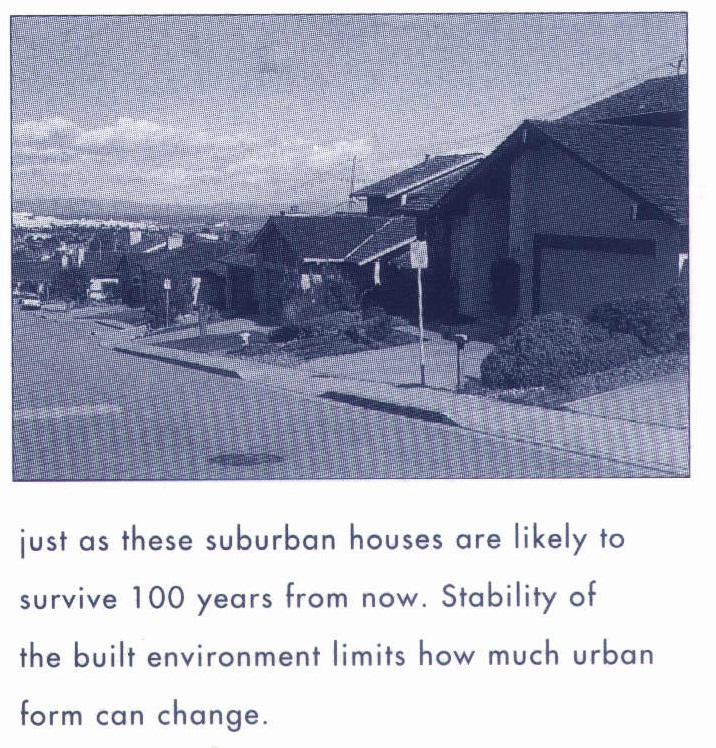
Transportation’s declining influence on locational choices reflects the way transportation services are priced. The price of private vehicle travel in the United States is very low. Private vehicle users do not pay directly for the pollution they generate or the congestion they impose on other travelers. Police and other emergency services, maintenance of local roads, and many other parts of the transportation system are supported indirectly by property and other taxes. Gasoline taxes, vehicle-registration fees, drivers license fees, and automobile taxes are lower here than anywhere in the developed world. Parking is offered free to most workers and shoppers. Given the extent of subsidies to private vehicle use, we should not be surprised that other forms of transportation cannot compete, and that people take advantage of the many personal benefits of private auto-mobility.
We should not be surprised that efforts to shift travel to other modes, either by promoting higher-density land use patterns or building massive rail systems, are doomed to fail if current automobile pricing policies are maintained. In Los Angeles, for example, it costs a lot to use rail transit as a lure to get commuters out of their cars. According to the transit operating agency’s data, full cost (capital plus operating) per passenger is $1.17 for bus; $11.34 for the Blue Line, a light-rail system operating between the downtowns of Los Angeles and Long Beach; and $21.02 for MetroLink, the commuter rail service. Budget shortfalls, partly resulting from the high subsidy cost of rail system expansion, have been met by reducing bus service; ironically thus reducing total transit riding.
Because land use development involves many factors besides transit investment, such as local land use policies, general economic climate, land availability, and local preferences for economic development, we must recognize the limited potential of transportation policies to affect land use, even if we were to “get the prices right.”
Aiming for Efficiency
Why should we attempt to guide land use patterns anyway? There are at least two possible rationales. The first holds that existing land use patterns are inefficient: low-density suburbs necessitate long trips and reliance on private autos, thus wasting energy, generating air pollution, requiring more public infrastructure, and consuming open space. This is the familiar anti-urban-sprawl argument. Newman and Kenworthy make a distinction between fuel-efficient transportation and fuel-efficient cities. They argue that while investing in highway facilities can make travel more efficient by reducing congestion, the added highway capacity will ultimately lead to more travel and thus more total energy consumption. They therefore advocate the promotion of “compact cities”: high-density, pedestrian- and transit-oriented cities.

Anthony Downs calculated changes in commuting distance resulting from changes in residential density. He assumed that densities can be increased only for new development because urban redevelopment is costly, has a limited market, and is typically opposed by residents. Table 6 shows some results. Average densities increase much faster than average trip lengths decrease, meaning that very large increases in density are required to realize significant travel savings. Interestingly, the greatest percentage reduction in trip length occurs when moving from low to medium density, while going from medium to high density yields only a small additional reduction.
Downs’s calculations, together with the results of the Los Angeles and Oregon planning studies, suggest that the compact city alternative would have at best a moderate effect on travel. A seemingly more effective strategy for reducing travel would promote moderate densities. If we were to restructure our transportation pricing policy, we might realize this objective.
Aiming for Social Equity
A second rationale for attempting to change land use and transportation patterns is to increase social equity. Peter Mieskowski and Ed Mills describe two contrasting theories of suburbanization. The first, called the “natural evolution theory,” explains sub-urbanization basically as the result of economic forces. City expansion occurs in conjunction with rising incomes. Thus, we find older, smaller housing near the city center and larger, newer housing at the periphery. If this theory holds, there is little justification for attempting to change land use patterns: low-density, suburban environments are simply the result of household preferences associated with rising incomes.
The second theory explains suburbanization as the result of the affluent population escaping the fiscal and social problems of central cities. Higher-income households, able to pay the higher transportation costs involved, move to the suburbs to form homogeneous communities that are fiscally independent of the central city. Once they establish such communities, they can exercise land use controls to exclude households 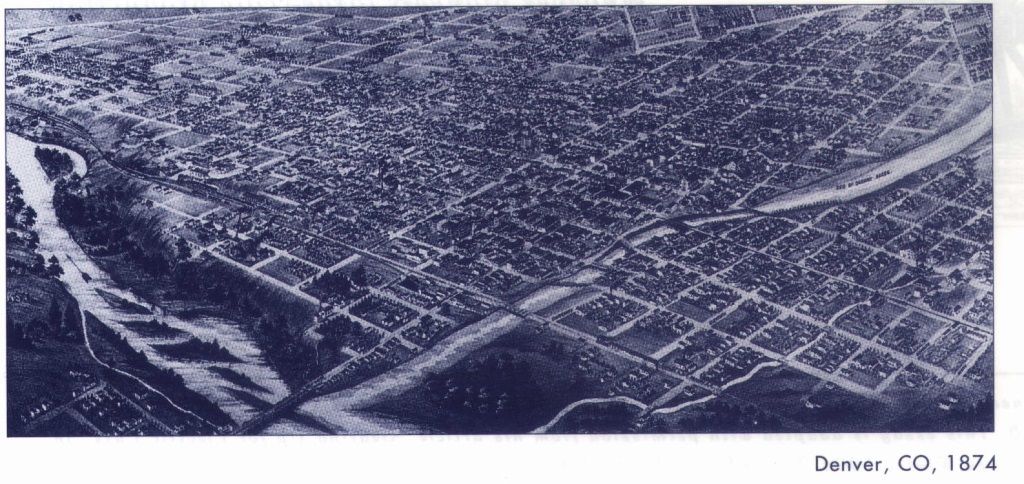 with different housing needs or preferences. This process results in spatial segmentation of the population on the basis of income, ethnicity, and race; people most in need of public services concentrate in the central city; and the central-city tax base declines.
with different housing needs or preferences. This process results in spatial segmentation of the population on the basis of income, ethnicity, and race; people most in need of public services concentrate in the central city; and the central-city tax base declines.
If the second theory holds, intervention is justified because suburban residents are actively preventing a spontaneous mixing of population, thus denying less affluent and minority populations access to suburban jobs and suburban amenities. Evidence of exclusionary land use practices is extensive, and consequently policies to end such practices are surely worthwhile. I therefore propose that land use policy should focus on eliminating distortions in the land market. We should aim to eliminate barriers to more diverse land use patterns. Essentially, this is the complement of “getting the prices right” in transportation policy.
The roots of our transportation and land use policy dilemmas lie in the absence of consensus on which environmental and social conditions are truly problematic. In turn, they reflect our confusion about how changes in either transportation systems or land use policies might work to ameliorate those environmental and social problems. If the aim is to reduce environmental damage generated by automobiles, the effective remedy is to directly price and regulate autos and their use, not land use. If the aim is to reduce metropolitan spatial segmentation, the effective remedy is to expand the range of housing and employment choices, not travel choice. As urban areas continue to evolve, the link between land use and transportation will likely continue to weaken. Thus only direct policy interventions can solve the social and environmental problems associated with existing travel and land use patterns.
Further Readings
M. Cropper and P. Gordon, “Wasteful Commuting: A Re-Examination,’• Journal of Urban Economics, Vol. 29, No. 1, 1991 , pp. 2 – 13.
Anthony Downs, Stuck In Traffic: Coping with Peak Hour Congestion (Washington, D .C. : Brookings Institution, 1992).
Genevieve Giuliano, ”New Directions for Understanding Transportation and Land Use,” Environment and Planning A , Vol. 21 , 1989, pp. 145-159. UCTC No. 2 .
Genevieve Giuliano and Kenneth A . Small, “Is the Journey to Work Explained by Urban Structure?”· Urban Studies, Vol. 30, No. 9, 1993, pp. 1485-1500. UCTC No. 107.
B . Hamilton, ” Wasteful Commuting Again ,” Journal of Political Economy, Vol. 97, 1989, pp. 1498-1504.
Peter Mieskowski and Ed Mills, “The Causes of Metropolitan Suburbanization,” Journal of Economic Perspectives, Vol. 7, No. 3, 1933, pp. 135-147.
Peter Newman and J . Kenworthy, “The Transport Energy Trade-Off: Fuel Efficient Traffic versus Fuel Efficient Cities,” Transportation Research A , Vol. 22A, No. 3, 1988, pp. 163- 174.
M. White, “Urban Commuting Journeys Are Not ‘Wasteful’ , ” Journal of Political Economy, Vol. 96, 1988, pp. 1097-1110.

